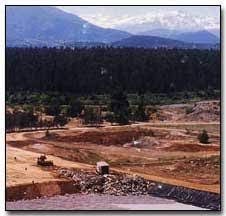Sanitary landfill also known as controlled tipping is the practice of waste disposal in which waste is stacked to decay under controlled conditions. Wikipedia Encyclopedia defines it as a site for the disposal of waste materials by burial.
Historically, landfills have been the most common methods of organized waste disposal and remain so in many places around the world. Some landfills are also used for waste management purposes, such as the temporary storage, consolidation and transfer, or processing of waste material (sorting, treatment, or recycling).

Landfills are sites where waste is isolated from the environment until it is safe. It is considered safe, when it has completely degraded biologically, chemically and physically. Four basic conditions should be met before a site can be regarded as a sanitary landfill.
Read Also : Criteria for Hygienic Storage of Solid Waste
The ways of doing this should be adapted to local conditions. The immediate goal is to meet, to the best extent possible, the four stated basic sanitary landfill conditions, with a longer term goal to meet them eventually in full. Figures (A, B, C): Landfill Sites in Poland, Ontario and Perth.

Basic Requirements of Sanitary Landfill
As a minimum, four basic conditions should be met by any site design and operation before it can be regarded as a sanitary landfill:
Full or partial hydro geological isolation: if a site cannot be located on land which naturally contains leachate security, additional lining materials should be brought to the site to reduce leakage from the base of the site (leachate and help reduce contamination of groundwater and surrounding soil.
If a liner – soil or synthetic – is provided without a system of leachate collection all leachate will eventually reach the surrounding environment. Leachate collection and treatment must be stressed as a basic requirement.
Formal engineering preparations: designs should be developed from local geological and hydro geological investigations. A waste disposal plan and a final restoration plan should also be developed.
Read Also : Traditional Solid Waste Disposal Methods
Permanent Control: trained staff should be based at the landfill to supervise site preparation and construction, the depositing of waste and the regular operation and maintenance.
Planned waste emplacement and covering: waste should be spread in layers and compacted. A small working area which is covered daily helps make the waste less accessible to pests and vermin.

